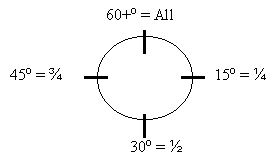After a couple of cancelled lessons, followed by a week on holiday, it had been a while since my last lesson. Too long! The weather forecast was for light cloud and plenty of wind, which isn’t exactly what you’d hope for. Luckily enough, although the weather wasn’t great, it was good enough for circuits, so I headed to the airport and had the pre-flight brief.
The standard circuit direction is left hand, meaning you’d take off, turn to the left, left again, fly parallel with the runway before turning left and left on to final approach:

The active runway today was 22, with a right-hand circuit, so we’d be doing the opposite. Right hand circuits are harder than left-hand, primarily because as the pilot (in the left hand seat) has a restricted view whilst turning right (you are up high). Surface wind was fairly strong, coming from 210degrees at 18knots, gusting higher.
Whilst talking about the wind, I was introduced to the max drift calculation. When flying with wind, unless the wind is directly behind or ahead of you, it will be blowing you off-course. Without correction, the stronger the wind blows, the more off-course you’ll be from your desired heading. The maximum drift correction calculation enables you (unsurprisingly!) calculate the maximum angle you’ll drift, given your air speed and wind speed. To calculate:
max drift = (60 / air speed) * wind speed
For example, if we were cruising at 90kts, with a wind speed of 21:
max drift = 60/90 * 21 = 14 degrees
Maximum drift applies if the wind is blowing at 90 degrees to the plane (eg if it is blowing at you directly sideways). We know that if the wind is blowing head-on (or directly from behind), no correction is required. Therefore we need a way to calculate the correct drift correction amount (which could vary between 0 and the max drift) for when the wind is between 0 and 90 degrees to the plane.
There are various ways to calculate this, although for me I think the easiest will be using the clock rule:

15º = quarter past therefore ¼ the drift
30º = half past therefore half the drift
45º = quarter to, therefore ¾ the drift
60º or more – apply all the drift
When on final approach, the standard approach is 3º. To roughly calculate the descent speed required for a 3º approach, we can use:
ft/min descent = 5 x ground speed in knots
So, if we are on final approach at a ground speed of 50 knots, we’d need to descend at 5 x 50 = 250 ft/min to be on a 3º glidepath.
Note that this is ground speed – not airspeed!
Another thing I learnt today is that airfield windsocks are typically calibrated to show wind speed, as well as direction. When fully extended (eg blowing 90º parallel to the ground) the speed is at or above 25 knots. You can therefore approximate the speed if it’s between 0 and 25 by looking at the angle to the ground.
For my first lesson of circuits, I’d be concentrating on flying the aircraft. My instructor would handle the radio and the checklists.
After the pre-flight briefing, we went out to the hangar and performed the usual pre-flight inspections. Everything ok, so we taxyed out and got up in the air. It was very bumpy up there with the wind, and it was fairly hard keeping straight and level. My first circuit was pretty wonky to say the least, but it did seem to improve with each touch and go.
After 6, I was pretty exhausted so we decided to call it a day. A lot happens in a very short space of time (it’s about 5 – 7 minutes per circuit) so it can be quite stressful! I was lucky I didn’t have to worry about the radio and checklists this lesson – no doubt that will be even more difficult when I’m ready to try that.
My other instructor is off work with a bad back (ouch!) so my next few lessons have been cancelled. Weather-depending, my next lesson will be a week today and we’ll either be doing more circuits or stalling part 2.
Unfortunately, the GoPro decided to stop recording before we’d taken off, so I didn’t capture any video from this lesson. However, I did capture our flight using the GPS in my iPhone, so here are my first circuits:
What app do u use to track your gps.
I enjoy reading your blog as i can compare with what you learned during your lesson with what i have learned and fill any gaps in my knowledge.
Thanks
Glad you enjoy the blog!
Have a look at this blog post for info on recording GPS tracks.